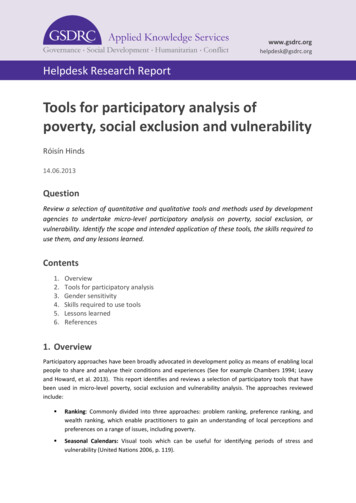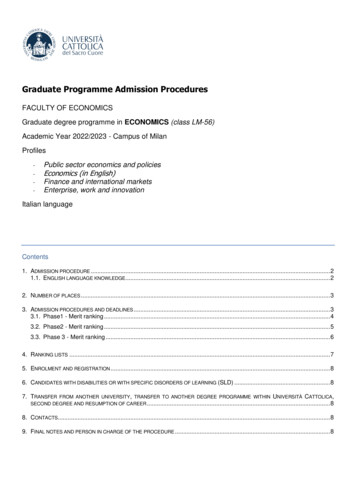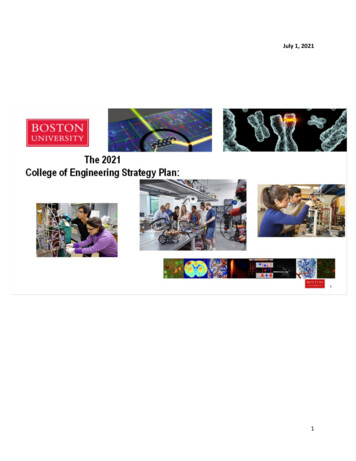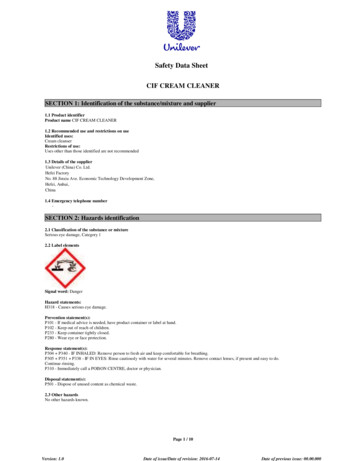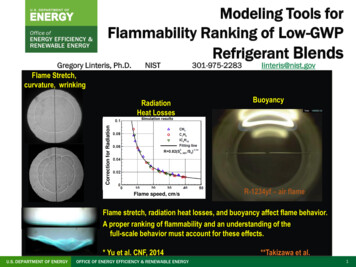
Transcription
Modeling Tools forFlammability Ranking of Low-GWPRefrigerant BlendsGregory Linteris, Ph.D.Flame Stretch,curvature, wrinkingNISTlinteris@nist.govBuoyancyCorrection for RadiationRadiationHeat Losses301-975-2283Flame speed, cm/sR-1234yf – air flameFlame stretch, radiation heat losses, and buoyancy affect flame behavior.A proper ranking of flammability and an understanding of thefull-scale behavior must account for these effects.* Yu et al. CNF, 2014U.S. DEPARTMENT OF ENERGYOFFICE OF ENERGY EFFICIENCY & RENEWABLE ENERGY**Takizawa et al.1
Project SummaryTimeline:Start date: Oct. 1, 2016Planned end date: Sept. 30, 2019Key Milestones1. Burning velocity data/predictive tool for HFCs (9/17)and HFOs (9/18).2. Generalized burning velocity predictive tool forblends (9/19)3. Input into codes and standards test methoddevelopment (9/19).Key Partners:AHRIITV, RWTH Aachen (Pitsch)ASHRAENortheastern Univ. (West)ISOUniv. of So. Cal. (Egolfopoulos)UTRCW.P.I. (Jayachandran)GexconPeking Univ., China (Chen)UMdAIST, Japan (Takizawa)(Sunderland)Project Outcome:Budget:1.Develop predictive tools for the laminar burningTotal Project to Date:velocity of low-GWP refrigerants, so that blendscan be optimized by industry to maximize DOE: 1350kperformance while minimizing flammability. Cost Share: 700k (NRC post-doc, NIST2.Build and validate kinetic mechanisms (full andequip. grant, ½ Greg’s Salary)Total Project : DOE: 2000k Cost Share: 875kU.S. DEPARTMENT OF ENERGYreduced) to allow for DNS modeling of firethreats.3.Provide technical input into the codes andstandards development process to facilitate thesafe implementation of low-GWP, mildlyflammable refrigerants.OFFICE OF ENERGY EFFICIENCY & RENEWABLE ENERGY2
TeamNIST:G. Linteris : Project Manager, past experience with HFCs for fire suppression,experiment/modelingV. Babushok*, D. Burgess* : kinetic model developmentJ. Manion* : shock-tube measurements of elementary rates, mechanism developmentR. Burrell (NRC post-doc): burning velocity measurement, constant volume and constantpressure methods (leaving spring 2019; replacement to be found).M. Hegetschweiler: 1D, 2D numerical modelingUniversities:H. Pitsch* (ITV, RWTH Aachen Univ.): simultaneous schlieren/PIV measurements, 3Dmodeling, flame dynamicsR. West (Northeastern Univ.): mechanism optimization, reductionF. Egolfopoulos* (Univ. So. Cal.): thermo. modeling of constant-volume experimentsJ. Jayachandran (WPI) : HTDR/TORC modeling of constant-volume experimentsZ. Chen*, Peking Univ. : ASURF modeling of 1D, unsteady, spherical flames with radiationP. Sunderland (UMd) : evaluation of existing flammability test methods (ASTM E681)Industry / Goverment:Standards Organizations:Gexcon : Explosion modeling, burning velocity expts. ASHRAE (Standard 34, T.C. 3.1)AHRI : coordination with industry.ISOArmy Research Lab: ARL, APG, ATC, SERDP.* World leader in their respective field.U.S. DEPARTMENT OF ENERGYOFFICE OF ENERGY EFFICIENCY & RENEWABLE ENERGY3
ChallengeProblem Definition: Existing HFC working fluids for vapor compression HVAC systemshave high GWP and will be phased out per the Kigali Agreement. The implementationof this agreement, according to the Natural Resources Defense Council, is equivalent(with regard to radiative forcing) to stopping all fossil-fuel combustion for two years.New low-GWP fluids have been, and are being, developed; however, they areflammable and the lack of codes and standards for their safe use is a major obstacle totheir rapid adoption. The US HVAC industry is onboard with adoption of the low-GWPcompounds, although flammable working fluids in residential and commercial settingsis a new concern for them; hence, they need help ranking and understanding theflammability risk of different options.To achieve the performance and GWP goals, industry will use blends (up to fivecomponents). To optimize the blends, techniques exist to predict the thermodynamicperformance and GWP; however, there are no methods to predict the flammability.U.S. DEPARTMENT OF ENERGYOFFICE OF ENERGY EFFICIENCY & RENEWABLE ENERGY4
ChallengeFlame Angle: 85o“non-flammable”95o“flammable”This flammability test depends upon burning velocity (buoyant flow , flame speed )Can this test result be predicted? Yes!Can full-scale flammability behavior be understood better? Yes!U.S. DEPARTMENT OF ENERGYOFFICE OF ENERGY EFFICIENCY & RENEWABLE ENERGY5
ApproachLaminar Burning Velocity (LBV) is foundational: much fire behavior depends upon it.Goals:- To develop the ability to predict the laminar burning velocity LBV of an arbitrary blend so thatindustry can optimize the blends with regard to flammability.- To model and understand the burning velocity/flammability test methods so that industryhas an accurate and relevant standard test method.- Improve the understanding of full-scale flame behavior to reduce flammability risks.1. Assemble team (experimental, modeling, kinetics).2. Get experimental LBV data for select pure compounds, over range of fuel/air mixtures.3. Build kinetic models (shock-tube studies, quantum mechanical calculations, etc.).4. Get flame modeling tools. (1-D, 2-D, time-dependent, spherical, with radiation).5. Understand what’s modelled and what’s measured.6. Compare experiments with model (validate model).8. Develop predictive tool, f(humidity, Tinit, Pinit), pure compounds, mixtures, humidity).9. Outputs:a.) Predictive tool for the burning velocity of refrigerants.b.) Validated kinetic mechanisms (full and reduced).c.) Technical input to standards development.U.S. DEPARTMENT OF ENERGYOFFICE OF ENERGY EFFICIENCY & RENEWABLE ENERGY6
ExperimentsConstant Pressure Method, 30 L chamberConstant Volume Method, 1.8 L ChamberSchematic diagram.Thermodynamic ModelZ-type shadowgraph setup, overhead view.Quartz0Parabolicmirror0Flame Speed cm/sCameraLight sourceTypical Flame ImagesU.S. DEPARTMENT OF ENERGYOFFICE OF ENERGY EFFICIENCY & RENEWABLE ENERGY7
Other State-of-the-Art Approaches:1. Practical refrigerant release flammability experiments:a.) essential to get an overview of the behavior.b.) are mostly build-it and burn it empirical tests.c.) little interpretation of reasons for observed behavior.d.) too many parameters to get a full assessment of the range of risks.e.) costly and time-consuming to perform.f.) controlling parameters not systematically varied.2. Scenario modeling using numerical fire models (e.g. FLACS)a.) requires input: - burning velocity data over a range of equivalence ratio- response of flame to stretch and transition to turbulenceb.)can be used to cover more cases and wider range of conditions.c.) depends upon the accuracy of the model.d.) currently, not validated by experiments.Full-scale numerical simulations of the behavior of refrigerant-air flames cannotcurrently predict the experimental behavior.U.S. DEPARTMENT OF ENERGYOFFICE OF ENERGY EFFICIENCY & RENEWABLE ENERGY8
ImpactDirectly supports BTO Emerging Technologies 2016-20 MYPPGoal : Enable 45% reduction in building EUI in 2030 vs. 2010 EUI HVAC/WH/AppliancesStrategy 1: Near-Term Technology ImprovementUnique Comparative Advantage:1. Existing approaches for understanding refrigerant flammability are largelyempirical and inadequate.2. Present approach is based on fundamental, detailed kinetics.3. Numerical simulations of the flame structure are used to to uncover role ofancillary effects (buoyancy, stretch, radiation).4. Can employ various levels of fidelity depending upon the need: (approx. kinetics;simplified radiation; planar vs. spherical flames, etc.)Realization of Impact:1. The goal is a usable design tool that can predict the fundamental laminar burningvelocity of refrigerant blends.2. Full-scale numerical simulations of the behavior of refrigerant-air flames, whichare required to cover the range of possible scenarios, depend upon accurate burningvelocity data and the response of the flame to stretch. The present project willprovide those, enabling better full-scale numerical simulations.U.S. DEPARTMENT OF ENERGYOFFICE OF ENERGY EFFICIENCY & RENEWABLE ENERGY9
Progress(project is ¾ through time, 2/3 through money)Accomplishments:1. Experimentsa.) obtained comprehensive burning velocity data for R32 and R152a (over range of equivalence ratio andoxygen concentration) for mechanism development.b.) modified data reduction technique to now account for the effects of thermal radiation on the inferredburning velocity from the constant volume experiments.c.) assessed the role of flame stretch (i.e., curvature) and radiation on the inferred burning velocity from theconstant pressure experiments.2. Kinetic Mechanismsa.) New shock-tube data for key elementary ratesb.) quantum mechanical calculations to extend literature elementary rates to T, P of flames.b.) Initial mechanisms for:- C1, C2 HFCs (R32, R41, R125, R134, R134a, R143, R134a, R152, R152a, R161).- fluoropropenes (R1234yf, R1234ze(E), R1243zf)b.) Comprehensive mechanisms for:- R32 (complete)- R152a (complete)- R125, R134a, R1234yf, R1234ze(E) (in work)U.S. DEPARTMENT OF ENERGYOFFICE OF ENERGY EFFICIENCY & RENEWABLE ENERGY10
Progress(project is ¾ through time, 2/3 through money)Accomplishments:3. Numerical Modelinga.) Performed DNS simulations (1D, unsteady, spherical flames with detailed chemistry and radiation heat losses)for experiments with the constant pressure method CPM and constant volume method CVM.b.) Modeled the effects of stretch and radiation on the inferred burning velocity for:- R32-air flames CPM (complete)- R1234y-air flames CPM (in-work)- R32-air flames CPV (in-work)- R1234y-air flames CPV (in-work)c.) Performed DNS simulations (2D, unsteady, buoyant flames with reduced chemistry) for diluted flames of CH4air and H2-air with LBV of about 5 cm/s to explore the role of buoyancy and the assumptions in the datareduction techniques typically used in the standard test methods in development for refrigerant-air flames.d.) Performed 1D, steady, planar flame speed simulations for a wide range of refrigerants, oxidizers, etc. andcompared with above 1D and 2D unsteady simulations.4. Generalized Burning Velocity Predictive Modela.) Wrote a platform-independent GUI front-end, mimicking the NIST software package REFPROP, for use in userfriendly determinations of laminar burning velocity, adiabatic flame temperature, overall chemical reactionrate, etc. for an arbitrary initial conditions (refrigerant mixtures, Tin, Pin, humidity, oxidizer type, etc.).b.) Constructed an empirical model for refrigerant flammability (blends) based on Tad and F/H ratio, that matchesASHRAE Standard 34 database, for use in screening studies until our more detailed LBV predictive tool is ready.U.S. DEPARTMENT OF ENERGYOFFICE OF ENERGY EFFICIENCY & RENEWABLE ENERGY11
CH4CH2F22400210018001500401200900Burning velocity, cm/s600CH4303000CH3F-300-600-900-120020R16150R152a .212200R134aC2H6-2100R134Adiabatic Temperature, KCH3FBurning velocity, cm/s50Adiabatic Temperature, KPredicted Burning Velocity of C1, C2 HxFy volume fraction0.26CHxFy, volume fraction*Experimental data of: K. Takizawa, et al.U.S. DEPARTMENT OF ENERGYOFFICE OF ENERGY EFFICIENCY & RENEWABLE ENERGY12
Predicted Burning Velocity of Flouropropenes*C3H3F430C3H3F330YFZEE20XO2,ox 0.50.5150.50.3310XO2,ox 0.2525Burning velocity, cm/sBurning velocity, 91.11.31.5Equivalence ratio0.50.70.91.11.31.5Equivalence ratio*Experimental data of:K. Takizawa, K. Tokuhashi, S. Kondo, Flammability assessment of CH2 CFCF3: Comparison withfluoroalkenes and fluoroalkanes, Journal of Hazardous Materials 172 (2009) 1329-1338.U.S. DEPARTMENT OF ENERGYOFFICE OF ENERGY EFFICIENCY & RENEWABLE ENERGY13
Predicted Burning Velocities45R1234yf and 1234ze(E)40% O 2 , 3 bar, 400 KCalcAdiabatic12Experiments4040% O 2 , 2 bar, 350 K3530Burning velocity, cm/sBurning Velocities (cm/s)R3235% O 2 , 2 bar, 350 K2525% O 2 , 3 bar, 400 K201525% O 2 , 1 bar, 298 K1021% O 2 , 1 bar, 298 2H2O, volume fractionOptically thin0Numericalmodeling1234yf61.21.3Equivalence Ratio- Mechanism works very well for R32.- Calculated LBV agrees with adiabatic assumption for high P, T (as expected).- “ ““““““ optically thin““low “““- With initial mechanism for R1234yf and R1234ze(E): effect of water vapor iscaptured.U.S. DEPARTMENT OF ENERGYOFFICE OF ENERGY EFFICIENCY & RENEWABLE ENERGY14
DNS Predicted Flame Radius vs time R321D, spherical, time dep., DNS with detailed transport and full chemistry: Effects of radiation and flame curvature are accurately modeled.(change in slope with time is due to effect of flame curvature).Thermal radiation and response to stretch influence flame acceleration and extinction,which are important in full-scale behavior.U.S. DEPARTMENT OF ENERGYOFFICE OF ENERGY EFFICIENCY & RENEWABLE ENERGY15
Stakeholder Engagement(project is in mid-late stage)Dr. Linteris is a member of committees addressing refrigerant flammability in AHRI, ASHRAE, andISO. He actively collaborates with other refrigerant flammability researchers at the ArmyResearch Laboratory, Univ. of Md, United Technologies Research Ctr., Advanced Institute ofScience and Technology (Japan), Honeywell, and Gexcon. Through these relationships hecommunicates his research findings to the standards, testing, modeling, and industrial partners.ASHRAE- Member T.C. 3.1: Refrigerants and Secondary Coolants, Research Subcommittee.- Active in SSPC 34, Flammability Subcommittee- Member of Project Management Subcommittee for ASHRAE-1806- To be a member of Project Management Subcommittee for new HF formation project- Active presenter at ASHRAE meetingsAHRI- Member AHRI Flammable Refrigerants Subcommittee. Helping to identify and guide newresearch on refrigerant flammability.ISO- Member of TC86, SC 8 / WG8: Burning Velocity Test Methods- Providing on-going detailed input to new ISO standard test methods on LBV using constantArmy Research Laboratory / SERDP- Active collaborator with researchers/engineers at ARL, APG, ATC.U.S. DEPARTMENT OF ENERGYOFFICE OF ENERGY EFFICIENCY & RENEWABLE ENERGY16
Front-end GUI for use by industry to estimate flammability of refrigerant blends.1. Idea based on existing NIST tools: Ref Prop, Ref Leak: refrigerant thermodynamicproperties for blends, leakage rates for blends.2. Will allow users to estimate the LBV of refrigerant blends at arbitrary composition, initialtemperature, pressure, and humidity.3. Currently uses Cantera or Sandia 1D premixed flame calculation.4. Can estimate LBV using stirred reactor overall rate.U.S. DEPARTMENT OF ENERGYOFFICE OF ENERGY EFFICIENCY & RENEWABLE ENERGY17
Stakeholder EngagementRelevance in the face of advances in the market and competitive forces:Because this project is fundamentally based, it can be modified as new refrigerants come tomarket. For example, a recent application to ASHRAE Standard 34 is a blend based on thecompound CF3I. We can adopt and improve the existing kinetic mechanisms for CF3I, updatedrecently for its use as a fire suppressant, so that our burning velocity predictive tool could beused for refrigerant blends containing it.The ability to predict the flammability behavior of a blend of agents will be very useful toindustry. As an interim step until our work is complete, we have developed and published amethod of predicting the flammability rating as determined by the ASRHAE Standard 34 test andhave validated it against existing ASHRAE refrigerant database (see ref. [2] and [3] below).U.S. DEPARTMENT OF ENERGYOFFICE OF ENERGY EFFICIENCY & RENEWABLE ENERGY18
Remaining Project WorkKinetic Mechanisms:a.) Comprehensive mechanisms for R125, R134a are nearly finished; those forR1234yf and R1234ze(E) are in work.b.) Integration of these two separate mechanisms (that for C1-C2 HFCs and forfluoropropenes) is in work.c.) More experimental data on mixtures needs to be collected and then used tovalidate the predictions. We expect it to compare well.Flame Modeling:a.) Current results indicate that radiation is very important for slow flames (LBV 6 cm/s), and could make a large difference in the inferred LBV from theexperiments; i.e., the literature data for very slow burning refrigerants may bewrong by a factor of 2 or 3. Hence, we need to verify that, and then develop ameans to correct for radiation effects—without the need for 1D timedependent DNS modeling.b.) ongoing DNS results with buoyancy should give us a good idea of whether thecurrent industry standard experimental data reduction method is correct.U.S. DEPARTMENT OF ENERGYOFFICE OF ENERGY EFFICIENCY & RENEWABLE ENERGY19
Remaining Project WorkGeneralized Burning Velocity Predictive Model:a.) The software tools need to make the predictions are complete. We are fairlyclose to predicting the laminar, steady, planar, 1D burning velocity of thecompounds originally stipulated; however, to be sure it’s working, we need tohave high-quality experimental data—that is corrected for the effects of stretch,buoyancy and radiation. Through numerical modeling, we are converging on agood understanding of these effects, and their influence on the burning velocitydata.b.) These findings are central to helping industry develop a suitable standard testmethod for burning velocity, since for fair comparison of different refrigerants,the effects of stretch, buoyancy, and radiation on the LBV needs to be quantified.U.S. DEPARTMENT OF ENERGYOFFICE OF ENERGY EFFICIENCY & RENEWABLE ENERGY20
Thank YouNational Institute of Standards and Technology (NIST)Greg Linteris, Ph.D.,301-975-2283 ; linteris@nist.govU.S. DEPARTMENT OF ENERGYOFFICE OF ENERGY EFFICIENCY & RENEWABLE ENERGY21
REFERENCE SLIDESU.S. DEPARTMENT OF ENERGYOFFICE OF ENERGY EFFICIENCY & RENEWABLE ENERGY22
PublicationsJournal Publications:[1] R. Burrell, J.L. Pagliaro, G.T. Linteris, Effects of stretch and thermal radiation on difluoromethane-airburning velocity measurements in constant volume spherically expanding flames, Proc. Combust.Inst. 37(3) (2019) 4231-4238.[2] G.T. Linteris, I. Bell, M.O. McLinden, An empirical model for refrigerant flammability based onmolecular structure and thermodynamics, International Journal of Refrigeration to be accepted (2019).[3] I. Bell, P.A. Domanski, G.T. Linteris, M.O. McLinden, Evaluation of binary and ternary refrigerant blendsas replacements for R134a in an air-conditioning system, International Journal of Refrigeration to beaccepted (2019).[4] G.T. Linteris, V.I. Babushok, Predicted Burning Velocities of C1 and C2 Hydrofluorocarbon RefrigerantFlames with Air, International Journal of Refrigeration submitted (2019).[5] M.J. Hegetschweiler, G.T. Linteris, J.L. Pagliaro, Effects of stretch and radiation on the laminar flamespeed of CH2F2 (R32) - Air mixtures, Combust. Flame to be submitted (2019).Conference Papers:[6] G.T. Linteris, V.I. Babushok, Predicted Burning Velocities of C1 and C2 Hydrofluorocarbon RefrigerantFlames with Air, 2018 Eastern States Section Meeting of the Combustion Institute, The CombustionInstitute, State College, PA, 2018.U.S. DEPARTMENT OF ENERGYOFFICE OF ENERGY EFFICIENCY & RENEWABLE ENERGY23
PublicationsConference Papers (cont.):[7] D.R. Burgess Jr, J.A. Manion, R. Burrell, V.I. Babushok, M.J. Hegetschweiler, G.T. Linteris, Developmentand validation of a mechanism for flame propagation in R-32/air mixtures, 2018 Eastern StatesSection Meeting of the Combustion Institute, The Combustion Institute, State College, PA, 2018.[8] G.T. Linteris, I. Bell, M.O. McLinden, An empirical model for refrigerant flammability based onmolecular structure and thermodynamics, 17th International Refrigeration and Air ConditioningConference at Purdue, July 9-12, 2018, Purdue University, West Lafayette, IA, 2018.[9] I. Bell, P.A. Domanski, G.T. Linteris, M.O. McLinden, Evaluation of binary and ternary refrigerant blendsas replacements for R134a in an air-conditioning system, 17th International Refrigeration and AirConditioning Conference at Purdue, July 9-12, 2018, Purdue University, West Lafayette, IA, 2018.[10] G.T. Linteris, V.I. Babushok, Numerically-Predicted Burning Velocities C1 and C2 HydrofluorocarbonRefrigerants with Air, 17th International Refrigeration and Air Conditioning Conference at Purdue, July 912, 2018, Purdue University, West Lafayette, IA, 2018.[11] V.I. Babushok, M.J. Hegetschweiler, G.T. Linteris, Flame Propagation in Mixtures of Moist O2/N2Oxidizer with Fluorinated Propene Refrigerants (CF3CFCH2, CF3CHCHF, and CF3CHCH2), 11th U. S.National Combustion Meeting, March 24, 2019 - March 27, 2019, The Combustion Institute, Pasadena,CA, United states, 2019.U.S. DEPARTMENT OF ENERGYOFFICE OF ENERGY EFFICIENCY & RENEWABLE ENERGY24
PublicationsConference Papers (cont.):[12] D.R. Burgess, J.A. Manion, R.R. Burrell, V.I. Babushok, M.J. Hegetschweiler, G.T. Linteris, ValidatedModel for Burning Velocities of R-32/O2/N2 Mixtures over a Wide Range of Conditions, 11th U. S.National Combustion Meeting, March 24, 2019 - March 27, 2019, The Combustion Institute, Pasadena,CA, United states, 2019.[13] R.R. Burrell, M.J. Hegetschweiler, D.R. Burgess Jr, J.A. Manion, V.I. Babushok, G.T. Linteris, R-152a/airand R-134a/oxygen constant volume spherical flame burning velocity measurements, 11th U. S.National Combustion Meeting, March 24, 2019 - March 27, 2019, The Combustion Institute, Pasadena,CA, United states, 2019.[14] L. Berger, R. Hesse, K. Kleinheinz, A. Attili, J. Beeckmann, H. Pitsch, A DNS study of the impact ofgravity on spherically expanding premixed flames, The 9th European Combustion Meeting (ECM2019), The Combustion Institute, Lisbon, Portugal, 2019.Reports:[15] J.L. Pagliaro, G.T. Linteris, Burning Velocities of Marginally-Flammable Refrigerant-Air Mixtures,NIST Technical Note 1988,National Institute of Standards and Technology, Gaithersburg, MD, 2018, p. 17.[16] P.A. Domanski, M.O. McLinden, I.H. Bell, G.T. Linteris, Low-GWP Alternative Refrigerant Blends forHFC-134a, NIST Technical Note 2014,National Institute of Standards and Technology, Gaithersburg, MD,2018, p. 30.U.S. DEPARTMENT OF ENERGYOFFICE OF ENERGY EFFICIENCY & RENEWABLE ENERGY25
Project BudgetProject Budget: 2000kVariances: None.Cost to Date: 1350kAdditional Funding: 875k (Cost-share NIST, NRC, equip.); possibly SERDP.Budget HistoryOct. 1, 2016 – FY 2018(past)DOE 1400kU.S. DEPARTMENT OF ENERGYCost-share 700FY 2019 (current)DOE 600Cost-share 875OFFICE OF ENERGY EFFICIENCY & RENEWABLE ENERGYFY 2020 – N/A(planned)DOECost-share26
Project Plan and ScheduleOct. 1, 2016U.S. DEPARTMENT OF ENERGYMoneyTimeOct. 1, 2019OFFICE OF ENERGY EFFICIENCY & RENEWABLE ENERGY27
Effects of RadiationU.S. DEPARTMENT OF ENERGYOFFICE OF ENERGY EFFICIENCY & RENEWABLE ENERGY28
c.) Performed DNS simulations (2D, unsteady, buoyant flames with reduced chemistry) for diluted flames of CH 4-air and H 2-air with LBV of about 5 cm/s to explore the role of buoyancy and the assumptions in the data reduction techniques typically used in the standard test methods in development for refrigerant-air flames. d.)







